His Majesty Brunello, medieval landscapes
 The symbolic gatehouse to the kingdom of Brunello is without doubt the magnificent city of Siena, cradle of Italian art on the old pilgrim route from France to Rome, the Via Francigena. Leaving Siena by the south the route then winds towards Murlo, Pienza, to Montalcino itself. Amidst the Crete, the unique landscape of sandy hills eroded into shape by antediluvian waters, the old fortress of Montalcino is the last outpost of Sienese territory before reaching the woods of the Maremma and the heights of Monte Amiata. This is the setting for one of Italy’s most famous and most important wines, the first wine to compete on the stage of international wines for auction and for laying down in the cellar.
The symbolic gatehouse to the kingdom of Brunello is without doubt the magnificent city of Siena, cradle of Italian art on the old pilgrim route from France to Rome, the Via Francigena. Leaving Siena by the south the route then winds towards Murlo, Pienza, to Montalcino itself. Amidst the Crete, the unique landscape of sandy hills eroded into shape by antediluvian waters, the old fortress of Montalcino is the last outpost of Sienese territory before reaching the woods of the Maremma and the heights of Monte Amiata. This is the setting for one of Italy’s most famous and most important wines, the first wine to compete on the stage of international wines for auction and for laying down in the cellar.
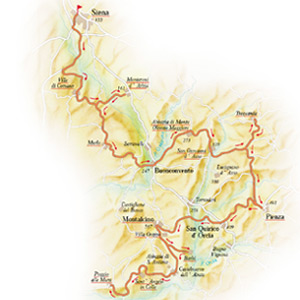
Siena
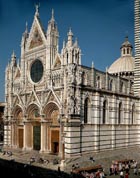 Siena, Italian capital of the Middle Ages, lies amongst ancient hills moulded out of age-old tufa and cradled between the Val d’Elsa and the Valdarbia. Legend has it that Senio and Aschio, the sons of Remus, founded Siena although the town really has Etruscan and Roman origins. The town’s structure was laid down during the late medieval period when the three hill districts of Città, Camollia and San Martino came together. After the Lombards, bishops and consoles had come and gone, Siena became a place of merchants and craftsmen and grew powerful on a colourful trade in textiles, spices, perfumes saffron, wines and waxes. Its flourishing past is evident in the magnificence of the walled town centre. Siena’s fine homes still stand as monuments to its wealthy former denizens. The town’s fabulous squares of heady proportion and the intensely religious nature of its Romanesque-Gothic churches bear witness to a scale of artistic endeavour unique in the world. But misfortune struck in the 14th-c.: famine and the black death decimated the people of Siena and brought their town to its knees. Siena was a broken city and lost its independence. Giangaleazzo Visconti, Pandolfo Petrucci, the Spaniards under the rule of Charles V and lastly Cosimo I de’ Medici prevailed and mastered the city. This brought about a terrible economic crisis that ended only in the 18th c. with the arrival of the Lorrainese. Nowadays Siena is a paradise for tourists. A spell seems to have been cast over the town and its inhabitants, because they are the only people in Italy who still observe an ancient and traditional feast day purely for their own pleasure: all their own proud feelings of citizenship are invested in the Palio.
Siena, Italian capital of the Middle Ages, lies amongst ancient hills moulded out of age-old tufa and cradled between the Val d’Elsa and the Valdarbia. Legend has it that Senio and Aschio, the sons of Remus, founded Siena although the town really has Etruscan and Roman origins. The town’s structure was laid down during the late medieval period when the three hill districts of Città, Camollia and San Martino came together. After the Lombards, bishops and consoles had come and gone, Siena became a place of merchants and craftsmen and grew powerful on a colourful trade in textiles, spices, perfumes saffron, wines and waxes. Its flourishing past is evident in the magnificence of the walled town centre. Siena’s fine homes still stand as monuments to its wealthy former denizens. The town’s fabulous squares of heady proportion and the intensely religious nature of its Romanesque-Gothic churches bear witness to a scale of artistic endeavour unique in the world. But misfortune struck in the 14th-c.: famine and the black death decimated the people of Siena and brought their town to its knees. Siena was a broken city and lost its independence. Giangaleazzo Visconti, Pandolfo Petrucci, the Spaniards under the rule of Charles V and lastly Cosimo I de’ Medici prevailed and mastered the city. This brought about a terrible economic crisis that ended only in the 18th c. with the arrival of the Lorrainese. Nowadays Siena is a paradise for tourists. A spell seems to have been cast over the town and its inhabitants, because they are the only people in Italy who still observe an ancient and traditional feast day purely for their own pleasure: all their own proud feelings of citizenship are invested in the Palio.
Piazza del Campo
 The excited crowd waits bearing colourful banners; the eyes of the world are on the straining horses and their eager jockeys. The starting pistol fires and they are off: the race is fast and hard, the winning post so near yet so far. The Palio di Siena held on July 2 and August 16 has been staged in Piazza del Campo for centuries. The Piazza, a medieval area of unparalleled beauty, is a fantastic shell of brick paving separated by grey stone strips into nine sections that converge on Palazzo Pubblico. This square has been the centre of town life in Siena since the end of the 13th c. and is enhanced by a backdrop of marvellous buildings, including Palazzo Sansedoni and Palazzo d’Elci.
The excited crowd waits bearing colourful banners; the eyes of the world are on the straining horses and their eager jockeys. The starting pistol fires and they are off: the race is fast and hard, the winning post so near yet so far. The Palio di Siena held on July 2 and August 16 has been staged in Piazza del Campo for centuries. The Piazza, a medieval area of unparalleled beauty, is a fantastic shell of brick paving separated by grey stone strips into nine sections that converge on Palazzo Pubblico. This square has been the centre of town life in Siena since the end of the 13th c. and is enhanced by a backdrop of marvellous buildings, including Palazzo Sansedoni and Palazzo d’Elci.
Battistero
The apse of the duomo, resplendent in gleaming white marble, forms a base for the 14th-c. Gothic Baptistery. The facade, punctuated by four pillars, contains three portals decorated by hanging arches and two-part windows. These are preceded by a pavement impressively decorated with baptismal scenes. The interior is a rectangle divided by two great pillars into a nave and two aisles with Gothic vaults. In the centre you can see a Renaissance font by Jacopo della Quercia. This consists of a pillar, a ciborium crowned by the Baptist and a hexagonal bowl, decorated respectively by Donatello, Giovanni Turino, Lorenzo Ghiberti, Goro di Neroccio and Jacopo himself. Jacopo also created the bronze cherubs, gilded bas-reliefs depicting stories of the Baptist and statues symbolising the virtues.
Duomo
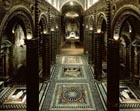 Black and white marble sets off Siena’s duomo to perfection amid a cacophony of Romanesque-Gothic architecture. This glorious monumental example of 13th-c. religious architecture was built over a previous cathedral and then extended by the addition of a cupola and apse. The building was then completed in several stages. Giovanni Pisano and Camaino di Crescentino began the work, which was continued by Giovanni di Cecco who completed the facade at the end of the 14th c. We owe the 19th-c. mosaics on the facade to Augusto Castellani while Enrico Manfrini designed the modern entrance. The facade is richly decorated: the entrances are crowned by triangular cuspids while the architrave is sculpted with Stories of the Virgin. These statues are copies: the magnificent originals are kept at the Museo dell’ Opera. Pointed arabesques and a central rose window give extraordinary movement to the facade, which is dominated by a Romanesque bell tower. The interior features a nave and two aisles divided by clustered pillars. The pillars rest on a marble floor unique in the history of religious architecture because it consists of no fewer than 56 sgraffito or inlay panels. As you walk through the church to the Piccolomini Library, art seems to come at you from all sides: sculptures, paintings, a chapel containing a Madonna del Voto, a baroque masterpiece by Gian Lorenzo Bernini and the high altar. The apse features a marvellous wooden choir and a fine round stained-glass window. Last but not least comes a pulpit by Nicola Pisano, an octagonal marble Gothic structure.
Black and white marble sets off Siena’s duomo to perfection amid a cacophony of Romanesque-Gothic architecture. This glorious monumental example of 13th-c. religious architecture was built over a previous cathedral and then extended by the addition of a cupola and apse. The building was then completed in several stages. Giovanni Pisano and Camaino di Crescentino began the work, which was continued by Giovanni di Cecco who completed the facade at the end of the 14th c. We owe the 19th-c. mosaics on the facade to Augusto Castellani while Enrico Manfrini designed the modern entrance. The facade is richly decorated: the entrances are crowned by triangular cuspids while the architrave is sculpted with Stories of the Virgin. These statues are copies: the magnificent originals are kept at the Museo dell’ Opera. Pointed arabesques and a central rose window give extraordinary movement to the facade, which is dominated by a Romanesque bell tower. The interior features a nave and two aisles divided by clustered pillars. The pillars rest on a marble floor unique in the history of religious architecture because it consists of no fewer than 56 sgraffito or inlay panels. As you walk through the church to the Piccolomini Library, art seems to come at you from all sides: sculptures, paintings, a chapel containing a Madonna del Voto, a baroque masterpiece by Gian Lorenzo Bernini and the high altar. The apse features a marvellous wooden choir and a fine round stained-glass window. Last but not least comes a pulpit by Nicola Pisano, an octagonal marble Gothic structure.
Pienza
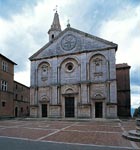 Mount Amiata and the Sienese hills act as a magnificent backdrop to this Renaissance jewel set in the Val d’Orcia. Pienza was built up over the medieval town of Corsignano by Bernardo Rossellino and Leon Battista Alberti. It owes its present form to the poetic spirit of Enea Silvio Piccolomini, i.e. Pope Pius II, a native of the area, who first had the idea of reorganising the town. The piazza named after him is a marvel of trapezoid architecture and overlooked by notable buildings such as a duomo by Rossellino. This contains masterpieces by Matteo di Giovanni, Sano di Pietro and Vecchietta. Other sights worth seeing include the Town Hall and Palazzo Piccolomini with its large picturesque loggia. Not far away, the Casa dei Canonici house a fine Cathedral Museum containing Sienese works of art.
Mount Amiata and the Sienese hills act as a magnificent backdrop to this Renaissance jewel set in the Val d’Orcia. Pienza was built up over the medieval town of Corsignano by Bernardo Rossellino and Leon Battista Alberti. It owes its present form to the poetic spirit of Enea Silvio Piccolomini, i.e. Pope Pius II, a native of the area, who first had the idea of reorganising the town. The piazza named after him is a marvel of trapezoid architecture and overlooked by notable buildings such as a duomo by Rossellino. This contains masterpieces by Matteo di Giovanni, Sano di Pietro and Vecchietta. Other sights worth seeing include the Town Hall and Palazzo Piccolomini with its large picturesque loggia. Not far away, the Casa dei Canonici house a fine Cathedral Museum containing Sienese works of art.
Montalcino
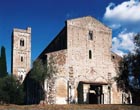 Anyone who loves good food and good wine will have heard of Montalcino. The popular wine produced in the Sienese hillside vineyards overlooking the Ombrone and Asso valleys is known as Brunello di Montalcino. The town, originally an Etruscan and Roman village, now features a splendid medieval plan. Circled by a wall and dominated by a 14th-c. fortress with a pentagonal plan, the old town centre contains the Palazzo dei Priori, now home of the Town Hall, a fine loggia with two Gothic stone archways and a notable civic and diocesan museum containing extraordinary works of Sienese art.
Anyone who loves good food and good wine will have heard of Montalcino. The popular wine produced in the Sienese hillside vineyards overlooking the Ombrone and Asso valleys is known as Brunello di Montalcino. The town, originally an Etruscan and Roman village, now features a splendid medieval plan. Circled by a wall and dominated by a 14th-c. fortress with a pentagonal plan, the old town centre contains the Palazzo dei Priori, now home of the Town Hall, a fine loggia with two Gothic stone archways and a notable civic and diocesan museum containing extraordinary works of Sienese art.
|
THE PLEASURES OF THE TABLE |
|
| Salsiccia | Coppiette |
| Tuscan sausages vary considerably in size and make-up; generally the ones from Siena and the Maremma are bigger in girth. Indistinguishable from a salami in looks, they can be eaten either raw, like a salami, or cooked. Usually made of fresh pork, but in some areas made of much spicier wild boar meat mixed with pork. The pork is necessary in any case to soften the texture. Best grilled and served with polenta and roast vegetables, or served in a casserole stewed with cannellini beans. | Dried and smoked strips of beef or wild boar plaited together and seasoned with salt and pepper. Once found in all the Roman drinking haunts, where they were considered an excellent encouragement for drinking more liquid. A traditional antipasto in the southern Maremma area, which probably explains their spread in popularity as far as Rome. |
| Panforte di Siena | Pappa col pomodoro |
| A famous type of spiced and honeyed hard bread/cake, well known in many parts of Italy as far back as the XIII century. The ingredients are, amongst other things, sugar, candied peel, flour, bitter almonds, sweet almonds, ground nuts, spices and honey. Traditionally a Christmas dish, but the many versions of Panforte can be found all year round in Sienese cake shops and on the dessert menus of local restaurants and trattorias. | Of the many dishes in the Tuscan cucina povera repertoire, this is without doubt the most unusual and the simplest. There are many variations of pappa, but essentially it consists of tomatoes, olive oil, stock, stale bread, garlic and basil. Some cooks toast the bread first, other just mix it with all the other ingredients. The end result is a tasty pink-hued mixture called pappa all the same. It is the most austere and elementary of all soups. |
| Raviggiolo | |
| Cheese made from two milkings of sheep’s and goat’s milk (sometimes with additional cow’s milk). The curd is kept intact and left to take shape in little wicker baskets. Sometimes served on fern leaves. White, creamy and very smooth in texture. | |
|
IL VINO |
| Of all the Italian wine regions, perhaps Tuscany has the most ancient traditions of all. The Etruscans began cultivating vineyards here in the 8th century B.C. They used live trees as supports for the vines: today in some areas of Tuscany we can still find traces of this "elevated" form of cultivation. However it was during the period of the Roman Empire that Tuscan wines won the fame that would endure through the centuries until modern times. Today Tuscan wines are known and loved throughout the world, just as the Tuscan countryside is. Tuscany, of all the Italian regions, has been able to happily balance tourism with oenologia, partially due to its spectacular landscape. Splendid hills covered with vineyards alternate with lanes of cypress and olive groves. Here, more than anywhere else, the winemakers have been able to protect the environment and make the most of their natural resources: we can find areas of magnicent natural beauty that have remained identical to when they were painted by maestro Lorenzetti in the13th century! Curling around the medieval burgh of Montalcino, we find the production area, or better, the sanctuary, of a wine that has become legend: Brunello di Montalcino. Obtained from the Sangiovese grape, locally called Brunello, it represents the high point in quality of production in this region. Much of what makes this wine exceptional is due to the favorable conditions of the climate and terrain in which it is grown, but substantial credit must be given to the expertise of winemakers themselves, who insist on a long maturation process in casks of the best fine woods, utilizing techniques that have been passed down from generation to generation. In recent years, Brunello di Montalcino has become synonomous with incomparable quality, a sort of Italian ambassador in the elite group of the world's most exclusive wines. If you would like to prepare a lunch or dinner reminiscent of the area, click here to purchase wines carefully selected by our experts. |
|
EATING AND SLEEPING |
| Tuscan cuisine is famous all over the world and in this region one has a very vast choice. When in Siena we recommend the Sotto le Fonti winery (tel. +39 0577-226446), a lovely restaurant furnished in great style with traditional cuisine, such as homemade pasta Pici and Pannicelli, and an excellent selection of cheeses. It has a great wine list. Another restaurant in Siena is the Osteria Castelvecchio (tel. +39 0577-49586) a small restaurant with brick ceilings, which proposes dishes according to the season. Try the Carabaccia, a soup whose recipe goes back to the Middle Ages. A good address to know in Pienza is the Osteria La Porta (tel. +39 0578-755163), which serves regional cuisine such as, Pici, Malfatti, soups, stews and tomato pulp. The Porta also carries a great choice of Tuscan wines. If you chose to spend the night, you can do so in one of the most beautiful hotels just outside Siena: at the Certosa di Maggiano (tel. +39 0577-288180). This hotel was created from an antique monastery and it has a tranquil atmosphere, great service and its privacy and peacefulness justify the high prices. Another good address is the Locanda dell'Amorosa in Sinalunga (tel. +39 0577-679497) created from an antique country villa. It has only a few rooms, but they are very well taken care of. The old stables have been restructured in order to house the restaurant where home-grown products from the surrounding fields are served. |








